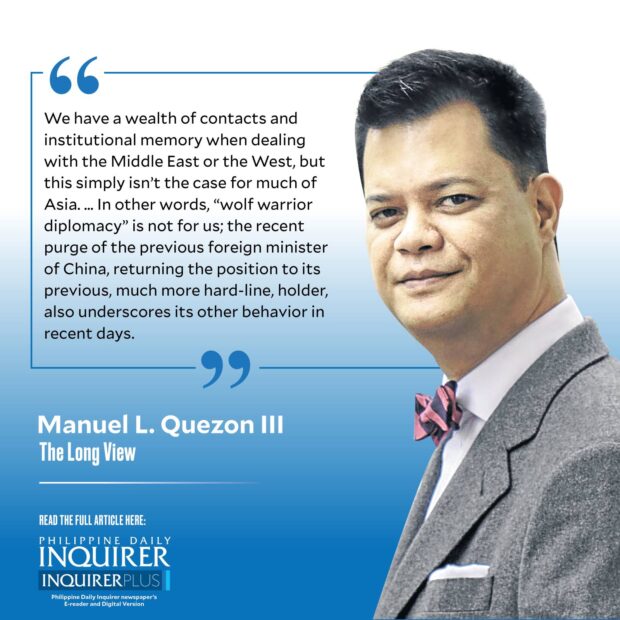Our listening post in Beijing
 When a photo was released of former president Rodrigo Duterte, cane in hand, visiting President Marcos, one caption in a social media chat naughtily read, “The Ambassador of China presents his credentials to the President of the Philippines.”
When a photo was released of former president Rodrigo Duterte, cane in hand, visiting President Marcos, one caption in a social media chat naughtily read, “The Ambassador of China presents his credentials to the President of the Philippines.”
What the President has done is to try to smooth over the provocation that was the unannounced Beijing visit of Duterte (and friends: he was accompanied by officials of the media outfit owned by the Federal Bureau of Investigation’s wanted preacher-media-mogul, Apollo Quiboloy, which tells you all you need to know about what the visit represented: a political lifeline). But as his haggard demeanor reveals, the President is hard-pressed to smooth over both Beijing’s behavior and that of his domestic critics.
A couple of days ago Beijing followed up its water cannonading with a verbal blast accusing the Philippines of leaving a previous pledge to remove the BRP Sierra Madre (claimed by some as a promise supposedly made by former president Gloria Macapagal Arroyo before a state visit by Hu Jintao).
For its part, the Department of Foreign Affairs (DFA), which has already filed over 30 notes verbales this year alone protesting China’s behavior, expressed dismay over the failure of the special communications line between Manila and Beijing, saying it went unanswered. For his part, Jay Batongbacal, director of University of the Philippines’ Institute for Maritime Affairs and Law of the Sea, believes “Hotlines with CN are not for communication, it’s to make the other side more uncertain about escalation, to allow one’s own fears get them to back down. As far as CN is concerned, the one who calls is the one who’s weak. Not answering shows who’s strong.”
An unhelpful suggestion was a grandstanding one from a congressman who said we should “downgrade” our embassy and “order our unusually quiet and inactive ambassador there to return to Manila” so he can be replaced. I happen to think that Beijing is one of the capitals where our country’s representative is vastly qualified to do a tough job, which is to keep Manila advised on Beijing’s moves and their meanings. That is far more beneficial than congressman-style grandstanding.
It would be well to understand, as the Prussian tactician Carl von Clausewitz would have recognized (“war,” he famously wrote, ”is diplomacy by other means”), that the use of water cannon by China’s coast guard, is part of that country’s “Gray Zone Tactics Playbook.” Gaute Friis describes what this represents: “A water cannon is generally considered an antipersonnel, nonlethal weapon, used to stop, discourage, or punish an unwanted activity. The tactic consists of blasting another ship with a high-pressure water stream. It is a mainstay in South China Sea incidents, as it is one of the very few ways ships at sea can kinetically attack other vessels in a way that is unlikely to cause severe damage to materiel or personnel.”
We have a wealth of contacts and institutional memory when dealing with the Middle East or the West, but this simply isn’t the case for much of Asia.
As he prepared to embark on a state visit to China, the late former president Benigno S. Aquino III asked to meet the DFA’s resident expert on China. The best that could be produced was a mild-mannered young diplomat who headed the China desk. After being briefed, Aquino asked us if there might be people with extensive knowledge of the politburo who could be consulted as resource persons. We suggested two longtime Beijing residents who were Filipino journalists: the late Chito Sta. Romana and Jaime FlorCruz. Edwin Lacierda was tasked to talk to Sta. Romana and I was instructed to get in touch with FlorCruz. Both gladly, and thoroughly, not to mention, discreetly, answered Aquino’s questions.
At the start of Duterte’s term, I was given the opportunity to meet and have a frank discussion with Sta. Romana and was convinced his great experience was truly at the service of the country. That included a sober appreciation on his part that much of the real diplomacy was being conducted through informal channels, bypassing him and, thus, without the benefit of his input, much less advice.
When Sta. Romana died in office, FlorCruz paid tribute in words that read as if they should be marching orders for the next ambassador, which, as it turned out, is precisely what FlorCruz ended up becoming. Sta. Romana, he said, helped “steer the bilateral relations with calm and steady hands,” because “he knew China inside-out. He knew how things there worked—and why,” keeping uppermost in his mind, “the best interests of our country and people.”
In other words, “wolf warrior diplomacy” is not for us; the recent purge of the previous foreign minister of China, returning the position to its previous, much more hard-line, holder, also underscores its other behavior in recent days.
Email: mlquezon3@gmail.com; Twitter: @mlq3




















